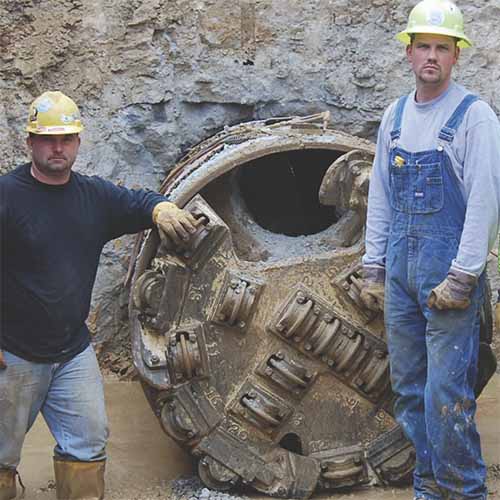Louisville, KY
Gene Snyder Expressway
Turn-Key Tunneling set a record by boring 352 linear feet of 54” casing under the Gene Snyder Expressway in Louisville, Kentucky.
After 35 working days of excavation, Ohio contractor Turn Key Tunneling Inc. had reason to celebrate. Their trenchless crossing beneath Interstate Highway 265 in Louisville, KY, had just been completed at an unprecedented bore length of 352 feet.
MAC Construction, "We are confident, even after testing the limits of the 54 inch SBU, that we could bore longer lengths given the right rock and project specifications". Typical jobs for the SBU-A are below 300 ft (90 m) in length, as smaller diameter SBU-As have successfully excavated crossings up to 500 ft (150 m).
The Robbins Small Boring Unit (SBU-A) is a type of trenchless boring attachment for use with standard Auger Boring Machines (ABMs). The SBU bores diameters from 24 to 72 inches (.6m to 1.8 m) is specifically configured to cut hard rock using a circular cutterhead mounted with disc cutters. The disc cutters are capable of excavating rock from 4,000 to over 25,000 psi (25 to over 175 MPa) UCS. The disc cutters are fitted with a variety of tungsten carbide bits and single or multi-row disc cutters.
In the launch pit, the machine is welded to the lead steel casing, while the ABM provides both torque and forward thrust to the cutterhead. Openings in the cutterhead called bore scrapers collect spoil from the face, where they are transferred to a full-face auger for removal.
Turn-key Tunneling launched the SBU-A on January 22, 2009 in conjunction with a 60-1200 ABM. The rock, consisting of limestone up to 20,000 psi (138 MPa) UCS, and the 2.91% grade presented challenges early on. The cutterhead drifted while boring through several dirt seams as well as a mud-filled cavern, which momentarily slowed progress. "We continued to make progressively smaller adjustments and the SBU responded very well. The last 200 ft we bored were very true and required little fine-tuning," said Roger Lewis, Project Superintendent for Turn-Key Tunneling. The machine broke through on March 11, just 0.17 in (4.3 mm) off of line and grade and well within its contractual ± 3 in (8 cm) requirements.
The method proved highly successful compared to other trenchless techniques. "Conventional tunneling for a 54" tunnel with a drill and blast technique would produce about a three to four feet per shift rate of production. On this crossing, blasting was not permitted so hand mining would have been no more than a foot or two per shift. Given these project restrictions, the SBU proved to be at least 5 times faster than hand mining," said Lewis.
Special conditions: Constructed under an active Conrail track with unstable soil. Project required ground pretreatment prior to tunneling to ensure minimum subsidence beneath the active railway.
Turn-Key employed JennChem stabilizer to meet the contract requirements on the pretreatment using 250 injection rods to solidify the loose fill above the tunnel limits. The project consisted of a 140-lf drive of 144' dia tunnel.
Further unforeseen issues included boulders and specialty backstop design/built to support initial jacking load of 960,000 lbs to launch the shield.


